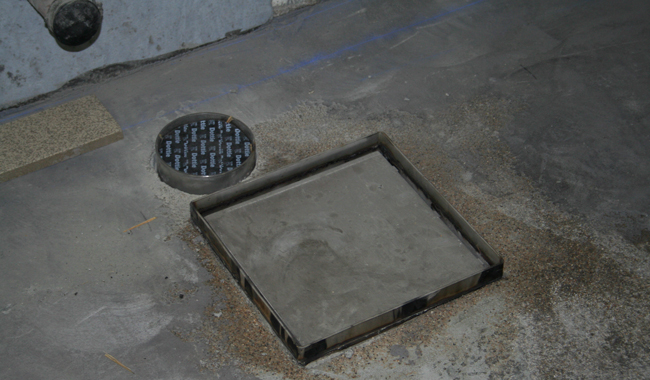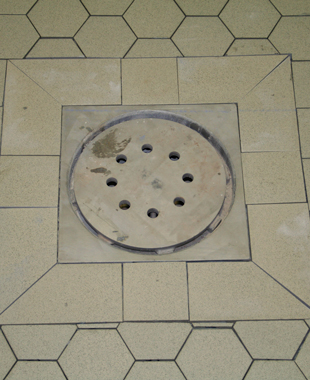
As previously noted, a floor is not a storage vessel, so provisions for draining the corrosives off the floor must be made. When considering any drainage method for an acid brick floor, please remember this cardinal rule of corrosion-resistant masonry construction:
The integrity of any system that relies on a membrane for primary barrier protection is weakened by any and all penetrations to the membrane. This includes (especially) terminations at floor drain hubs and against pre-cast trenches.
The three main methods used to drain acid brick floors are:
Floor (Spot) Drains
Usually located in the center of a square or rectangular drainage bay, a 25′ square bay with 2″ of pitch to a center drain is considered an “ideal” drainage pattern from the acid brick floor design standpoint. However, the amount of underground drainage piping required for this design is a significant drawback. Each floor drain creates an interruption in the membrane, and a potential place for corrosives to penetrate to the sub-floor.
Trench Drains
Trenches are commonly used in battery plants to drain the wetter environments. Precast trenches are available, made out of various corrosion-resistant polymers, incorporating the necessary slope into each successive section. Some precast trench drains have contributed to floor system failure due to:
The inability to properly seal the membrane against the precast system. This type of system will require a continuous interruption of the membrane at the most extreme point of exposure to corrosives.
Improper sealing of the separate sections of precast to each other, leading to leakage of corrosives below grade. For these reasons, we do not recommend precast trench drains for use in the extremely corrosive conditions found in battery plants.
This trench design will require specific exact dimensions for the top ledge detail and requires the slope for drainage to be poured into the concrete floor. Although this system has higher initial costs and is more difficult to construct properly, it has proven itself to be the most durable way to collect corrosive drainage water.
SUMPS
In smaller areas, it may be easiest to pitch the floor to a single collection sump and incorporate a ledge, such as illustrated above, into the perimeter edge. For either trenches or sumps, the most desirable way to remove the accumulated solution is by pumping. Incorporating a penetrating drain hub into a sump or trench will bring a risk of system failure around the penetration. If a penetrating drain is used in either case, the trench or sump should be designed to operate in a (normally) dry condition. The trench or sump should not be used for storage of corrosive solutions if there are penetrations used to drain the corrosive solutions.
